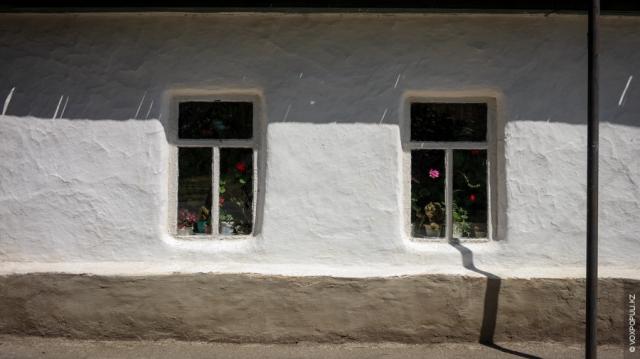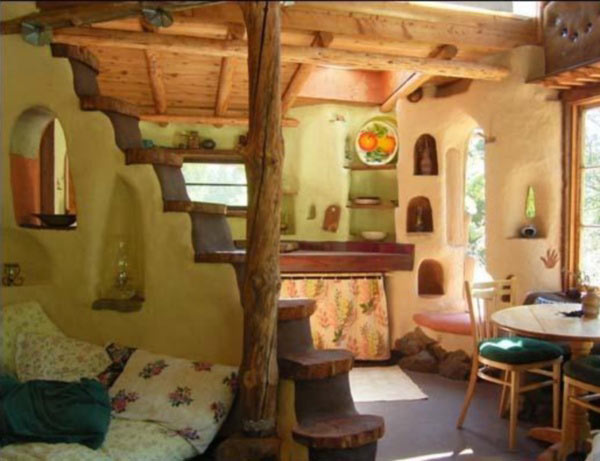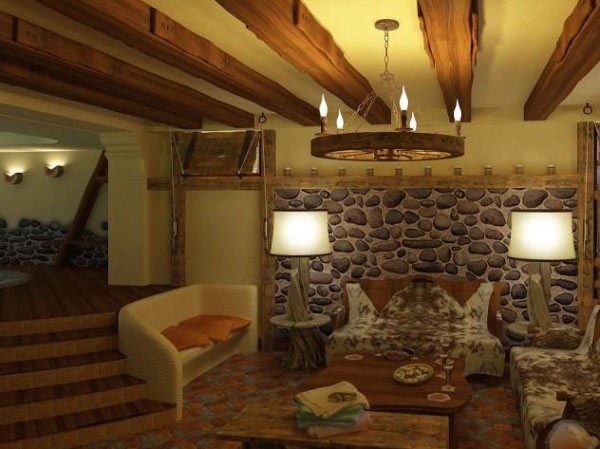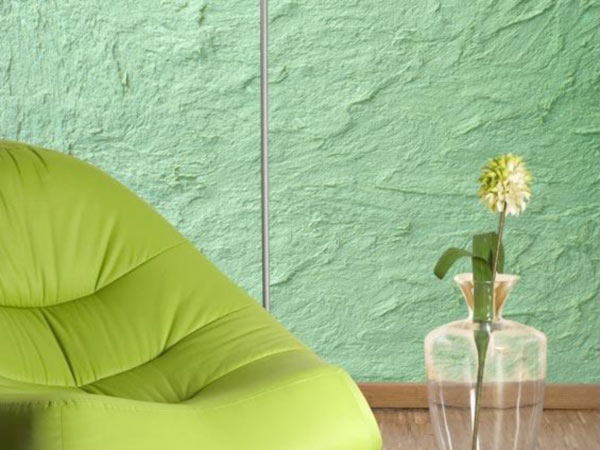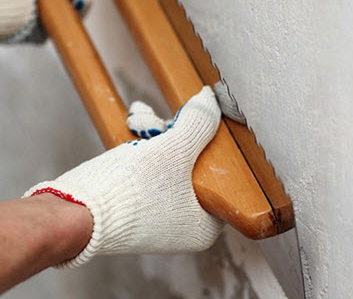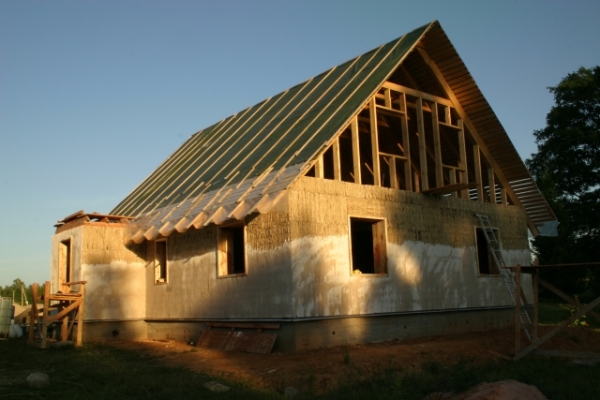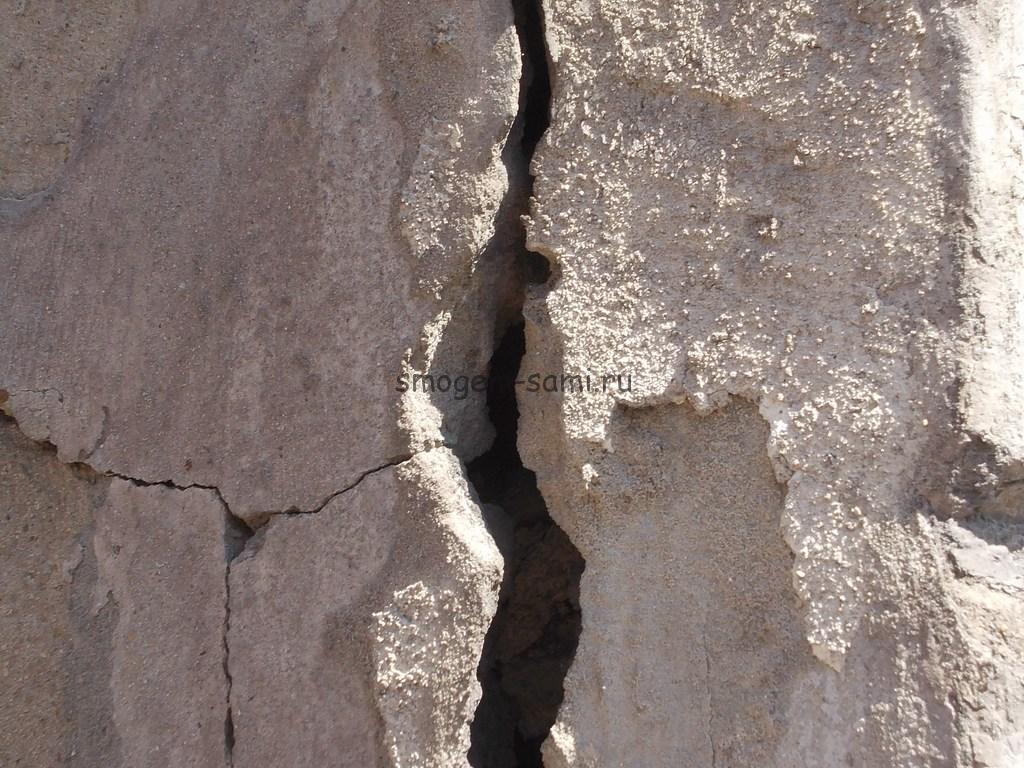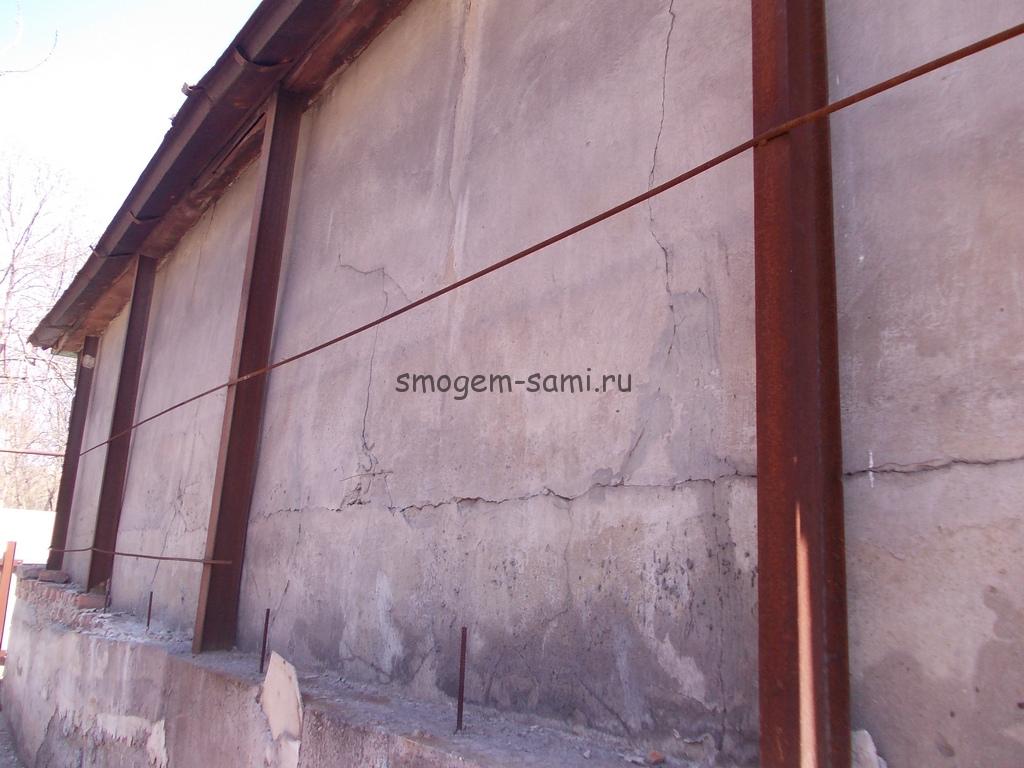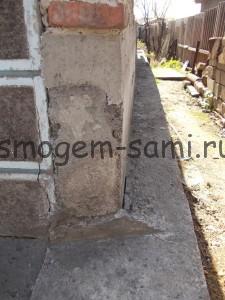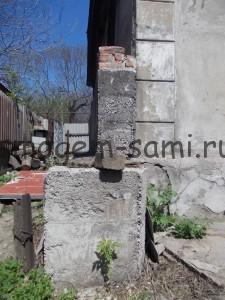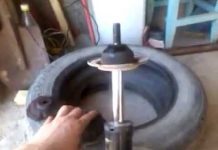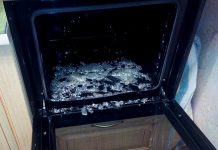In detail: do-it-yourself repair of adobe walls from a real master for the site my.housecope.com.
We have an adobe house, due to circumstances we have to repair ourselves. The problem is that the side (blank) wall is curved, that is, the belly. We want to cover the house with siding, and it is in this place that we cannot put up the racks. The wall needs to be cut off by 20-25 cm. But it’s scary, suddenly the wall will not be able to withstand the load from the roof (the length of the wall is 13 m, the “belly” is about 4 meters in the middle). I wondered if adobe could be chopped at all? And yet, with what modern materials can be used to plaster adobe, there is simply clay, but sawdust, shells, chaff cannot be found. The sand does not fit the clay, they say it will burst.
Thank you in advance, Angela, Krasnodar Territory.
Hello Angela from Krasnodar!
The decorative closure of adobe houses with siding has recently been practiced quite often.
Although it is not entirely clear, if you are going to install siding, then why plaster the adobe walls?
What is adobe? This is clay (medium fat, fatty or very fatty) and it is taken depending on the fat content per unit volume / for example, 1 cubic meter / from 1 to 4 parts /. Sand - 1 part. Fibrous fillers take (also depending on the fat content of the clay) from 8 to 18 kilograms. Sometimes sawdust, shells, chaff, of which you speak, are also used.
Purely for plastering adobe walls, they take a lime-clay solution (1 part of lime, 1 part of clay, 0.5 part of chaff, chaff, etc.).
Therefore, it is not possible to make plaster only in the presence of clay and sand.
There are no modern substitutes for such plaster. At least they are unknown to me. Although you can experiment and eventually find something suitable.
| Video (click to play). |
The famous Avicenna at one time said “do no harm!”, I mean that it’s not worth crushing the “belly” of the wall, which protrudes tens of centimeters beyond its dimensions. This can lead to collapses, especially with this size of the house. The 14 meters long wall is impressive. Typically, the roof in such buildings rests on a harness (usually made of wood) along the top of the wall. And if you reduce the thickness of the wall over 4 meters, then if not the entire roof, but only in this place, can sag. Do you need it?
In my opinion, you should make a decorative ledge in this place, where there is a "belly". That is, the frame for siding along the section of the wall to its "belly" is made in one plane. Then step back to the aforementioned maximum 25 centimeters and install the frame over the entire four meter length of the ledge. Then, after the ledge, you continue to frame the wall as at its very beginning.
The resulting two inner and two outer corners of the ledge are decorated with siding inner and outer corners. In the worst case, just siding strips ("G-elements"), which is cheaper. As a result, you will get a wall protrusion hidden by siding. If you wish, you can make it symmetrical with respect to the length of the entire wall. An outsider, unfamiliar with your difficulties, looking at the wall will not understand at all what is there, and how. The protrusion is the protrusion.
This is my vision of the answer to your question. Maybe someone will advise and more sensible.
Other questions about adobe houses:
Our site is regularly updated with interesting and unique materials and articles on the topic of lumber, building materials and work, the author's opinion and knowledge of a real shabashnik with more than 15 years of experience is given. There is a section - funny stories of shabashniki. If you would like to receive information about this, subscribe to the newsletter of our website. The non-transfer of your address to third parties is guaranteed.
If you own an old adobe house, do not despair, because, in principle, there is nothing wrong with the restoration. Knowing how to put everything in order, you can repair an old adobe house on your own and without problems. In fact, an adobe house is a building made of clay, that is, unbaked raw bricks, which, if possible, were lined with ordinary bricks around the perimeter.
Like any repair, it all starts with an inspection of the building, drawing up a work plan, an estimate and the purchase of the necessary materials. If you are not sure that you can carry out all the work on your own, then it is better, of course, to turn to qualified workers. The main elements of any residential building are the foundation, walls and roof, so let's look at everything in order.
In adobe buildings, the classical foundation was rarely used, that is, the walls of the house were erected on a compacted clay pillow. Or, in the version of an adobe structure, wooden pillars were driven into the ground, which were subsequently coated with clay. When inspecting the building, if you see the presence of cracks on the walls, the difference at the level of the window openings, then with a 100% guarantee we can say that the house has shrunk and the foundation needs to be repaired under the walls.
Option to strengthen the foundation of an adobe house
To do this, trenches are dug along the walls, but not in a continuous strip, but in increments of approximately one meter and a depth of about 0.6 m. Waterproofing is done along the lower edge of the adobe blocks. In problem areas, sections of the foundation are laid (the simplest option, reinforced concrete or sand-cement blocks). After that, it is imperative that waterproofing is done around the entire perimeter and a blind area is constructed.
One of the main problems of adobe walls is that a "belly" appears after a long time: irregularities and bulges appear on their surface. If such irregularities are up to two centimeters in size, you can try to clean them up, and when there are more, it is better not to take risks, but to think over a way to cover them (in the case of a facade, you can use siding, inside drywall).
Plastering adobe walls inside the house
During the construction of adobe houses, all floors were mainly made of wood. Therefore, it is necessary to assess the condition of the floor beams and if they are in a deplorable state, they need to be completely changed. Of course, this is a large amount of work, since you will have to disassemble the roof, replace the entire piping and make new wooden floors.
The roofs of such houses used to be covered with what was at hand: from reeds to ceramic tiles. When restoring an old roof, the first thing to start with is to inspect the entire wooden structure. If necessary, replace the worn-out elements and treat the entire crate, for example, with mastic.
Before starting roof repairs, it is necessary to carefully examine all its elements.
If the old roof is covered with tiles, it is advisable to replace it with a lighter material, since, having a lot of weight, it creates an undesirably large load on the entire structure of the house.
When deciding to carry out a complete renovation of a building in the first place, never neglect the advice of experts. Since, unknowingly, you can cause irreparable damage to the entire building, which ultimately affects your budget.
Decorating the walls of a house made of adobe is an unlimited scope for creativity and the implementation of creative ideas, as well as the opportunity to create environmentally friendly housing to your taste. The main thing when choosing finishing options is to preserve a favorable microclimate of an eco-house, take into account the recommendations of specialists on the choice of materials and strictly observe the installation technology.
Adobe construction is the best solution for those who value energy efficient and healthy technologies. And although adobe is not an innovation in construction, the quality and performance of the material has turned the ancient technique of constructing cheap housing into a technology of the 21st century.The main advantages of an adobe house - a mixture of sand, clay, water and straw: heat capacity, reliability, positive effect on the human body, medicinal properties, durability (hundreds of years), natural moisture exchange. An additional "plus" is the unique exoticism of the adobe house and the opportunity to realize any design passages in the interior.
Saman is a 100% healthy material that creates a favorable microclimate in the room. Radium is especially useful in adobe, which helps to remove from the human body everything that decomposes, rots and leads to cellular disorganization. In addition, radium has a positive effect on the nervous system, which is why the ancestors living in clay houses did not complain about their health. Therefore, the main thing when choosing materials is to preserve a healthy, unique and curative microclimate of an eco-home.
- The decoration of the walls from the inside of the adobe house performs only decorative functions - the enclosing structures DO NOT NEED to be protected! Therefore, when choosing materials, it is enough to pay attention to environmental friendliness, vapor permeability and aesthetic characteristics.
- The best finishing option is leveling the walls with a small layer of adobe and painting limewith natural dye... When choosing dyes, it is recommended to give preference to mineral based on metal oxides - resistant compositions that well retain the brightness of paints throughout the entire service life.
Important! It is not allowed to use for interior decoration of an adobe house. cement, modern latex and water dispersion paints! The latter are undesirable for two reasons: 1) insufficient vapor permeability; 2) the presence of polluting processes that are used in production.
Modern manufacturers offer a wide palette of shades of mineral dyes, which provides talented designers with unlimited scope for the implementation of original ideas. A good solution for interior decoration is a combination of wall painting and natural stone cladding.
- The simplest finishing option is wallpapering: prime the walls with highly diluted glue, let dry and glue the material canvases.
- All types of plasters, including gypsum, are suitable for decorating an adobe house. Textured "antique" plaster looks fascinating, which emphasizes the effect of adobe walls - this is not only an opportunity to please the eye with a rough texture and give yourself pleasant tactile sensations, but also a proven way to recreate the cozy atmosphere of a rural house with excellent sound-absorbing properties.
From the point of view of preserving the unique microclimate of an adobe house, it is undesirable to use drywall, since the gypsum board sheets create an insulating air gap that prevents the walls from accumulating heat and warming up from the inside. Therefore, due to the loose adhesion of drywall to curved enclosing structures made of adobe, freezing of the walls is possible.
When decorating the walls of an adobe house, special attention should be paid to lovers of ceramic tiles. The easiest way is to stick the cladding on a clay mortar - a short-lived option, since the tiles will fall off over time. Therefore, experts recommend using this type of decoration in rooms where it is difficult to do without cladding (bathroom, toilet, kitchen).
If the cladding with ceramic tiles fits well into the interior and is considered as the main type of decoration, then the use of drywall would be the best solution. First, you need to screw the gypsum board sheets directly to the walls using long self-tapping screws, or pre-make a frame from galvanized profiles, and then fix drywall to it. After that, prepare the surface, perform the cladding with ceramic tiles - and the beautiful wall will delight the eye with a spectacular view of the stylish finish.
 Author Topic: Redecoration in a house with SELF walls (Read 7851 times)
Author Topic: Redecoration in a house with SELF walls (Read 7851 times)
First, you need to tap the walls in order to find out if there are any voids under them. This can be done using a regular dough rolling pin. If in some place you hear a dull sound, then a pocket has formed there, that is, an emptiness and in this place the solution will soon move away from the wall. In this case, we need to get rid of the old solution and apply a new paint net to this place. We carry out these manipulations unless there is severe visible damage.
And what to do if you need to completely align? There are several options for leveling walls in an adobe house. But before proceeding directly to the alignment, you need to find out the level of deviation. To do this, we need beacons that we attach to the surface over the entire area where it is required to align the walls.
As an option for leveling the walls in an adobe house - the use of gypsum plaster. Gypsum plaster adheres perfectly to adobe and after finishing work on the plaster, thin traces of lighthouses will remain on the wall. After plastering the surface, it is imperative to putty. The method of leveling with gypsum plaster is quite lengthy and not entirely easy.
Another way of leveling such walls in the renovation of cottages can be the use of drywall. In accordance with the lighthouse, a metal profile must be installed; this can be done using the same gypsum plaster. If we choose this method, then it is advisable for us to first lay the material for heat or sound insulation on the wall. This will also make it possible to get rid of the space between the wall and the drywall sheet.
It is also possible to level such surfaces with clay plaster. Firstly, clay is an environmentally friendly material, and secondly, it perfectly absorbs moisture, which prevents moisture from entering the house. Clay plaster is applied differently from ordinary cement plaster, it must be spread on the wall with a float or spatula. Of course, a grater will be much more convenient.
After the first coat has been applied, let the surface dry for three days. And then repeat the plastering procedure. Clay plaster should be applied in three layers. The third is applied one day after the second and we make it much thinner than the first two. Flatten this finish layer.
After all the manipulations have been done, you should polish the wall, although in principle this can not be done. Such plaster can later be primed and painted, but if you carried out this work from the street, then you should cover the wall with a hydrophobe.
We've looked at several ways to level adobe walls. As you can see, they all require some skill and knowledge in the field of construction, in particular the application of plaster. If you are not confident in your abilities. It is better to entrust this matter to professionals who will know exactly which alignment option is right for your case.
In order to protect from the rain, houses made of wood or adobe (clay with chopped straw) are often sheathed with boards that rot intensively. And plastering a wall containing organic matter is not only useless, but also harmful. The coating cracks, the wall stops "breathing" and a fungus appears.
A more reliable solution is the use of modern plastic lining (PV), plus competent wall ventilation. You can even lay insulation.
Here is a diagram of such a design (Fig. 1). Air through the ventilation hatch penetrates into the space between the skin and the wall (or insulation), rises up and goes out near the roof. In this case, it is important that the ventilation gap is at least 1-2 cm.
The part adjacent to the ground (or blind areas) can be made of flat slate, depicting granite or tiled cladding with oil paint diluted with linseed oil (Fig. 2).
Why is PV best suited for these “dynamic” homes? Because it is not attached directly to the wall, but is installed using special brackets that allow the plastic to move, compensating for temperature changes and changes in the geometry of the building.
We cut slate sheets with a grinder. At the end adjacent to the lining, we form a chamfer so that the water flowing from the roof does not fall under the slate. We cut out the holes for the hatches, which should be located approximately in the middle between the installation beams.
As blanks, we use a neck with a lid d 33 mm from a plastic bottle (more, but not less).
We fix the hatch (fig. 3). On the inside, along the perimeter, apply a strip of silicone sealant. As a last resort - wrap with tow soaked in oil paint. We attach the slate sheets to the installation bar with hex head screws.
The easiest way is to install a plastic lining without insulation: we remove the boards, dissolve the highest quality boards on slats with the help of a circular. We fill them with a step of 50-60 cm. Next, we assemble the cladding using standard technology.
Of the insulation materials, rolled glass wool 120 × 5 cm is best suited.We cut the roll lengthwise into two equal parts.
Thus, the distance between the installation beams with a section of 7 × 7 cm will be 60 cm. We fasten the glass wool very carefully (Fig. 4) to avoid slipping, sagging and crumbling, which can lead to blocking of the ventilation duct.
Cover it from above with fiberglass facade plaster mesh and nail it down with plastic washers (cut from 4 × 4 cm baklashki). We put a copper wire under the washers, tying the canvas.
We nail plaster shingles in the center. Maintenance of the wall is very simple: in the spring we open the hatches so that it dries properly, and we close it for the winter.
It is impossible to use foam, pressed glass wool plates and mineral wool on aluminum foil for insulation - these are airtight coatings.
Saman is an environmentally friendly material made from a mixture of clay, straw, sand and water. Houses built from adobe are a real masterpiece that can stand and give comfort to those living in it for more than one hundred years.
However, as it is not difficult to guess, these buildings require a special approach to finishing, so further we will consider how and with what to plaster the adobe walls.
Plastering an adobe wall
Adobe houses have a number of advantages, among which, in addition to durability, a favorable indoor microclimate can be distinguished. It is cool in summer in such a house, and warm in winter. In addition, this construction option is, perhaps, the cheapest..
Therefore, adobe houses in Europe are becoming more and more popular every day. However, many abandon the idea of such a construction because they have no idea how the walls can be “put in order”.
In fact, there is nothing difficult in this, the main thing is to preserve the concept of an eco-friendly house, its main advantages and at the same time take into account some of the nuances of adobe walls.
Adobe brick wall
As you know, adobe structures do not tolerate moisture well, so the finish should be moisture resistant first of all. However, it should be said right away that traditional cement plaster is categorically unsuitable for these purposes. The fact is that such a coating has a high heat capacity, good thermal conductivity and poor vapor permeability.
As a result, moisture seeps from the inside of the house through the walls and settles on the inner surface of the cement finish, after which it flows down. At best, such a plaster of an adobe house will begin to crumble in a few years, at worst - this will lead to the complete destruction of the walls, which can occur in warm climates.
It is best to use a lime-based finish as a connecting link. This composition is easy to make with your own hands from lime and sand in a 1: 5 ratio. It is perfect for thick, coarse plaster. For finishing, a mixture is used in a 1: 1 ratio.
If the walls of the house are uneven, then to level them, you can make a solution with a small admixture of straw, manure or sawdust. This will strengthen the overall mass and thus avoid the need for a plaster mesh. The fact is that the mesh is fixed with long nails that destroy the walls.
Advice!
For internal plastering of an adobe house, you can use a mixture based on gypsum.
Before plastering the adobe wall, you must prepare it:
- First of all, the walls must be treated with a deep penetration primer twice. This will strengthen their surface, provide protection against microorganisms, and also improve the adhesion of the plaster to the base. (See also the article How to primer walls before plastering with your own hands.)
- After that, many experts recommend lining the walls with shingles, although this procedure is not always performed. For manufacturing, wooden slats with a thickness of no more than 5 mm are used, which are stuffed at an angle of 45 degrees to the horizontal with a step of 5 mm. On top of them, strips are attached, located at right angles to the first layer of shingles.
Advice!
If the plaster of adobe walls is carried out in this way, then the wooden slats must be treated with an antibacterial compound before installation.
Plastering an adobe house during construction
After the walls have been prepared, the coating can be started.
Instructions for performing this work are as follows:
Note!
Lime plaster should dry slowly at freezing temperatures.
Therefore, after application, the surface must be protected from direct sunlight and dry wind.
As we can see, this adobe plastering technology, although laborious, is quite feasible. At the same time, the house does not cease to be environmentally friendly, and the price for the covering is as low as for the rest of the materials from which it is built.
But, most importantly, the finish will serve as a reliable protection for the walls for many years. For more information on this topic, see the video in this article.
Repairing the load-bearing wall of an adobe house is a very unpleasant problem, the need to eliminate which is beyond doubt. And the reason for the appearance of such consequences is simple to the point of banality - non-observance of the basic requirements in the construction of buildings. In this case, the base of the house consists of natural stone laid out on the ground. Due to the lack of a high-quality foundation, cracks formed at the joints of the walls, deformation and bulging of the rear wall began to occur. To prevent further deformations and possible destruction, it is necessary to strengthen the wall of the adobe house.
Next, we concrete the above-ground part of the support. It can be done already. 30cm will be enough. We fill it to a height of about a meter. If possible, you can make a monolithic support with a size equal to the height of the wall that you want to strengthen.
8,892 total views, 1 views today
Quite often we are asked about our house plaster and wall covering (inside and outside). I will try to tell you a little more about plastering an adobe house in this article.
Let's remember the spring of 2014. The house is finally finished, the adobe walls are dry, the wheat sprouts on the walls are withered - you can start finishing.
I must say that the walls, erected using the technology of light adobe, are quite breathable. This is especially felt during strong winds)) The first winter, while the walls were drying, we felt it in full. And in the spring, as soon as it got warmer, they started plastering the walls. We already had experience in using clay plaster, and clay is at hand, so we did not think long about choosing a plaster mixture.
Raindrops on the wall. At first, the walls staunchly resisted the weather.
ADVANTAGES OF CLAY PLASTER: availability and low cost - the material, one might say, lies right under your feet, environmental friendliness, hypoallergenicity, fire safety. Absorbs unpleasant odors, allows walls to "breathe". Can be used as a finishing material.
THE COMPOSITION OF THE MIXTURE is simple - it is clay, sand and water. I also added some plaster. It allows you to adjust the shade of the plaster mixture - makes it lighter. And with it the solution dries faster.
Applying a rough plaster layer. Clay sticks to death. You can then tear it off only with a piece of the wall.
The proportions of sand and clay are selected depending on the "fat content" of the clay, and its composition may differ even in two adjacent areas. If plastering with oily clay, i.e. with a small admixture of sand - the plaster will crack when it dries. If the solution is "skinny", i.e. too much sand - the plaster will turn out to be loose and loose.
A lot has been written on the Internet how to determine the fat content of clay - by rolling balls or sausages, but there are no clear recommendations on how much sand to add in the end, so I immediately experimented on the wall. The result is a 1x2.5 ratio (one bucket of clay and two and a half sand). Before that, in an old house in the city, we used a 1x4 mix for plaster. We add quite a bit of gypsum to the solution, somewhere - 1/8 of a bucket (the more, the lighter the solution). The clay can be pre-soaked in a container in which the solution is mixed, and diluted with water until a homogeneous consistency, without lumps. And then add sand.
Correct consistency. )) The mortar is not too thick, but it also does not run off the trowel.
If the clay is dry and crumbly, you can, by removing or crushing large lumps, immediately mix with sand and gypsum, and then add water. Then, after preparation, the solution should be allowed to stand for a while so that all clay particles are soaked.
The mixture is diluted with water to the consistency of "thick sour cream".We applied the rough layer directly to the adobe wall, i.e., to put it mildly, on a non-smooth surface, and made the solution thinner - this way it better penetrates into all cavities, cracks and, when dry, adheres very firmly to the wall, and for the finishing layer it is more convenient make a thicker solution.
Smoothing the unevenness of the plaster walls. In a simple way - with a wet sponge. )) Only a sponge is needed dense, tough.
To prevent the finished wall from crumbling, crumbling or eroding when water gets in, we fixed it with a primer. They managed to try different primers from different manufacturers - acrylic, latex, concentrate, and ready-made solutions. In my opinion, there is no difference. Not a single crack has formed on the walls during the operation, it does not crumble anywhere, does not exfoliate. When water hits the walls, it rolls down and is not absorbed. By the way, the stones with which we faced the walls in the kitchen were attached to the same mortar of clay and sand. So far none have bounced)))
Kitchen decoration - clay and stones.
This is with regard to interior decoration.
Outside walls are more difficult. We also plastered them with clay and covered them with a water-repellent primer. We used a more concentrated primer, tried to moisten the walls deeper and better saturate the walls with it. The finishing layer of plaster was applied to the plaster mesh.
At the end of August 2014, our house began to transform ... Light adobe covers the beauty of clay.
At first we were pleased with the result. And in appearance and stability. The walls withstood the rains and temperature drops. But one of the walls was less fortunate than the others. The primer could not resist the lingering slanting rain for a long time, gradually the plaster began to get soaked. At night there was a frost, and in the morning in the sun the plaster began to fall off in flakes. True, only the topmost layer and not over the entire area of the wall, in small specks. It seems okay, but the view turned out to be unsightly. So the house stood until spring. The other three walls were not affected by the bad weather at all.
With the onset of heat, all the remaining plaster had to be stripped off on the south wall. Re-fixed the plaster mesh and plastered with a standard cement-based mortar as a finishing layer. He fixed it with a primer and covered it with two layers of facade acrylic paint on top. The rest of the walls are also painted. So our house became a cheerful peach color.
Andrey is painting the last piece of the wall.
True, then they covered it with another layer of paint. ))
In general, for my taste, clay plaster is ideal for indoor use. And the outer walls, either need to be protected from slanting rains - make houses one-story and with large roof slopes in the directions of the prevailing winds, or use other materials.
You can, of course, experiment with the old "old-fashioned" methods. For example, covering the walls with lime. But it is painfully smeared - it is better not to lean against such a wall, and requires constant renovation (we had an experience of "communication" with whitewashed walls, here we did not want to repeat it). And you can mix the solution with horse manure - the manure reinforces the plaster mixture well, prevents it from cracking and, it seems, makes it more moisture resistant. But we have not yet had time to test this technology. We went the easier way - we used a special plaster mesh to reinforce the finishing layer.
P.S. More photos of our house and the construction process here (we will replenish the album)
We wish you, friends, to build your own beautiful, cozy and eco-friendly home in the Family Estate!
The article was prepared by Sergey Rudenko, the owner of the Agudariya estate (PRP Fairy Tale).
Would you like to live with us on an estate in the woods by the river? Welcome to Apiterem (sleeping on hives and other wonders).
We invite you to the site dedicated to our beloved ECOdel! Coffee from acorns Amulet of the Family.
And if you feel that you know little about life on the estate and want to learn the most honest and practical information firsthand, from successful practitioners, we suggest listening to our webinar "Family Estate from A to Z" (duration 4.5 hours).
When using materials from this site - an active link to the source is required. Thank you for understanding.
Did you like the article? Support us with a link in social networks!
Hello. we have an adobe house of the 50s. I wanted to do the interior renovation myself. The walls are without cracks (like), but the surface is rough, covered with emulsion. Tell me, please, what and how is the best way to level the walls, so that then only cosmetic repairs can be done? Thank you.
There is always a lot of trouble with adobe houses of the old construction. But to be honest, the house is warm, and if it is well finished, it will serve for a long time. As for decorating the walls with your own hands. Everything will depend on what state they are in. You say that there are no cracks, the plaster holds well. But do not rush (I myself lived in such a house and I know that it hides many secrets).
First of all, tap the walls, you can do this with an ordinary rolling pin, with which you roll out the dough. Hear how they sound. If the sound is somewhere dull, then a pocket has formed under the plaster, there is a possibility that the old solution will completely disappear after a while. It is necessary to say goodbye to such a site, that is, to remove the old solution, which will have to be filled with a new one. By the way, you will definitely have to fill a paint net on this place, like a frame.
If the plaster of the walls is good, then you should not touch it. You will have to get rid of the water-based paint. You can moisten it and wash it with a rag, or peel it off with a net or spatula. Choose the method at your discretion, it will be more visible to you on the spot.
But it is imperative to align such walls. To do this, use gypsum-based fillers. If you are satisfied with not sucking flat walls, that is, you consider a small drop in the surface acceptable, then do everything yourself. But if you want to achieve maximum evenness and smoothness. Then you will have to resort to the services of a master.
A house built in the 50s and 60s, adobe, lined with bricks. On one side there is a small brick extension that has already cracked in the bundle. The total area of the house is 68 m2, of which 14 is an extension. The thickness of the front wall made of adobe is 45 cm, and from the side of the courtyard it is 25 cm, judging by the depth of the window sills. the windows are embedded in the brickwork. Today the floors in the extension were torn down and a small tunnel was made to look at the foundation, it turned out that it was not there at all. They dug inside from the front of the house, i.e. where the adobe wall is 45 centimeters. I took the photos as you asked, only I did not take pictures inside the house, the walls there are still without cracks.
How can an adobe house be strengthened? Does it make sense to start a repair in it or is it cheaper to demolish it?
Now we are going to replace the roof, lay a septic tank with concrete rings at a distance of 1.5 meters from the brick extension (nowhere else!) And make repairs.
I would be very grateful for your help and good advice!
The fact that there is no foundation is alarming. If there is a foundation and a tolerable condition of adobe walls, then it is possible and worth reconstructing. The problem is that, in principle, no one knows the bearing capacity of the walls. How to strengthen an adobe house? I would have made a good foundation, covered it with bricks, but you already have it overlaid. Armopoyas - I think it's not worth it, again, we don’t know the bearing capacity of the adobe walls, and the brick lining too. The conclusion is this: if the outer brick lining is strong and has a foundation (which most likely does not exist), then we change the roof, and the load of the rafters must be distributed between the adobe and the brick wall. But my opinion is - to demolish an old adobe house without a foundation.
The house is adobe, walls without lathing, sand and clay plaster, lime whitewash.How to properly approach the issue of leveling walls with putty (finishing) or how to properly prepare such walls for painting with water-based paint. thanks for the answer
Answer: If the house is old enough and there are significant cracks in the walls. Then it is better to cut them up and fill them with polyurethane foam. Of course, the easiest way to align walls in any house is with the help of drywall sheets if the question is about internal walls, or with the help of siding if you need to align the external walls of an adobe house.
If you have a desire (and you will have it a little later), then you can level the walls with plaster. A metal mesh is fixed to the surface of the wall, beacons are set up, choose a plaster mixture depending on its permeability to air and forward.
Due to the fact that you want to prepare the walls for painting, install the lighthouses as close as possible to each other, so you get a smoother overall wall plane.
Since you have an old plaster based on sand and clay, I advise you to choose the following plaster mixture: cement, sand and a little lime, you can replace the cement with liquid glass. At the same time, the outer wall will turn out to be vapor-tight and not soaked and will not crumble, even with mechanical stress on its surface.
I would not recommend using modern types of plaster mixes. God knows what the manufacturers have mixed there, and it will be expensive, since the consumption of such new mixtures for plaster on the grid is very significant and the price is also not small. Therefore, it is better to prepare a plaster sand-cement environmentally friendly mixture as described above.
I do not recommend installing drywall in houses from adobe, mice, various unpleasant insects and rodents of all brands and varieties settle very well behind it, and you will never evict them from there. And using poisons and chemicals for this is unlikely to be pleasant to you yourself.
| Video (click to play). |

